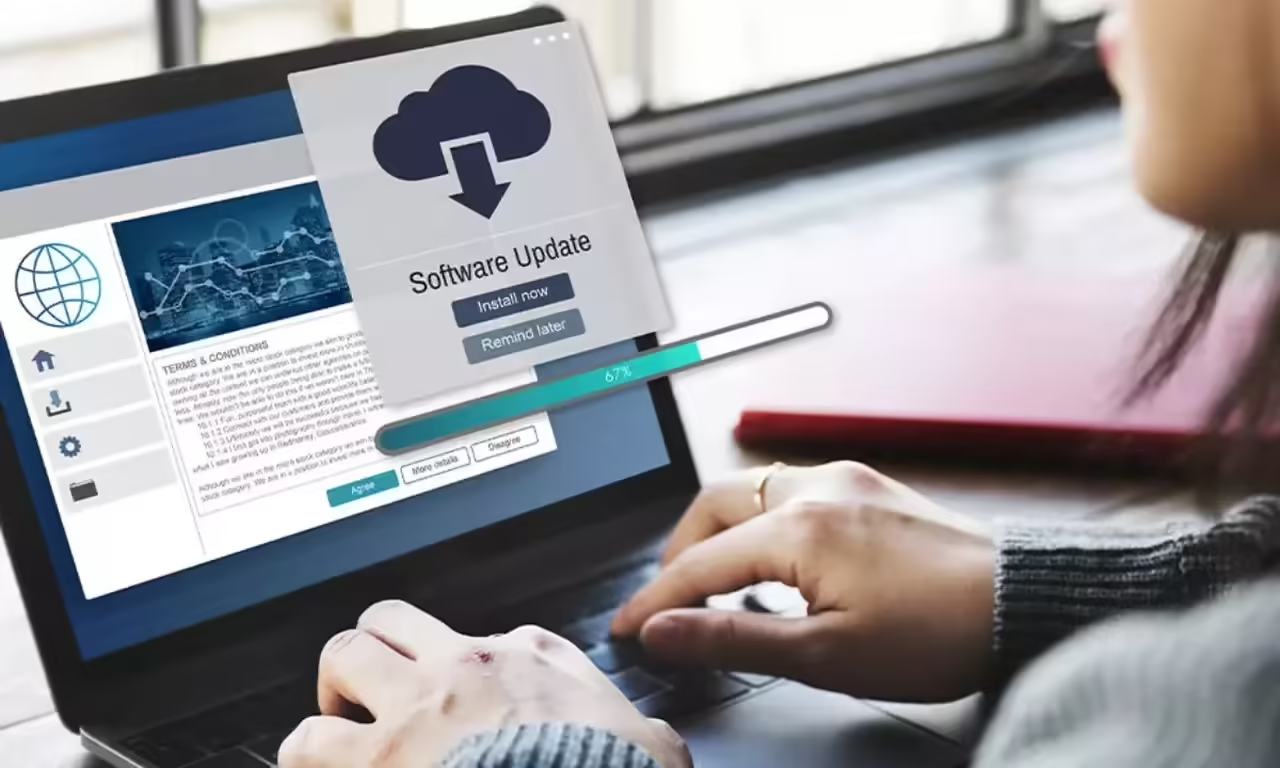
The Importance of Software in Our Daily Lives
In the digital era we live in, software has become a fundamental component of our daily lives. From the mobile devices we use to communicate to the complex systems that manage urban infrastructure, software is omnipresent and omnipotent, shaping our experience in the modern world in countless ways. In this article, we will briefly explore the importance of software in our daily lives and highlight the critical need to understand and apply regular updates to ensure its functionality, security, and ongoing relevance.
Software encompasses a wide range of applications and services that facilitate our daily activities. From social networking apps that connect us with friends and family to enterprise management systems that drive productivity in the workplace, software is intrinsically intertwined in the fabric of our modern existence.
On a personal level, software provides us with access to entertainment, information, and useful services. Streaming platforms allow us to enjoy movies, music, and TV shows from the comfort of our homes. Transportation apps make it easier for us to move from one place to another with a simple tap on our smartphone screen. Even in our household routines, software plays a vital role, controlling smart appliances, security systems, and thermostats to create more efficient and secure homes.
On a business level, software drives innovation, efficiency, and competitiveness. Companies rely on custom software systems to manage operations, analyze data, interact with customers, and automate processes. From e-commerce to healthcare, software optimizes operations and enables organizations to quickly adapt to changing market demands and customer needs.
The Need for Regular Updates
As software evolves to meet new demands and confront emerging challenges, it is imperative to understand the importance of regular updates. Software updates not only introduce new features and performance improvements, but also address security vulnerabilities, bugs, and flaws that could compromise system functionality or jeopardize user privacy and security.
The lack of regular updates can leave systems vulnerable to security exploits, malware, and other cyber risks. Hackers and cybercriminals are constantly seeking weaknesses in outdated software to infiltrate systems and steal confidential information, cause damage, or disrupt critical services.
In addition to security aspects, software updates also ensure compatibility with new technologies and standards, allowing users to take full advantage of the latest innovations. Keeping software up to date not only enhances the user experience, but also extends the system’s lifespan and ensures its optimal long-term functionality.
Security Vulnerabilities: Risks Associated with Using Outdated Software
In today’s digital landscape, where technology advances at a rapid pace, using outdated software poses a serious threat to cybersecurity. The vulnerabilities inherent in older versions of software create gaps that cybercriminals are eager to exploit. Here, we will examine the risks associated with using outdated software and how cyber threats can exploit these security gaps for their own nefarious purposes.
Risks Associated with Outdated Software
Unpatched Security Vulnerabilities: As new security vulnerabilities are discovered in software, developers often release patches and updates to address these flaws. However, if a user fails to install these updates, their system remains vulnerable to attacks.
Exposure to Known Threats: Hackers can exploit known vulnerabilities in outdated software versions. This means that even attacks that could have been prevented with an update may be successful due to lack of system maintenance.
Lack of Support: Over time, software developers stop providing technical support and updates for older versions of their products. This leaves users with outdated software even more exposed, as they have no access to security patches or assistance for security-related issues.
Cyber Threats and How They Exploit Security Gaps in Outdated Software
Malware and Ransomware: Malware and ransomware are common ways in which cybercriminals can exploit security gaps in outdated software. These malicious programs can infect systems through known vulnerabilities and, once inside, encrypt files or steal confidential information.
Zero-Day Attacks: Zero-day attacks are those that exploit newly discovered vulnerabilities before patches or updates are released to fix them. Outdated software versions are especially vulnerable to this type of attack, as they lack protection against the latest threats.
Exploitation of Known Exploits: Exploits are small programs or scripts designed to exploit specific vulnerabilities in software. Cybercriminals can use known exploits to penetrate systems that have not applied up-to-date security patches.
Software Patches and Updates: Enhancing Security and Functionality
In the world of software development, the terms “patches” and “updates” are crucial to ensuring that programs are secure, functional, and efficient. Here, we explore what software patches and updates are, and how developers use them to enhance the security and functionality of their products.
What are Software Patches and Updates?
Patches: A patch is a small modification or fix applied to an existing version of software to address specific issues. These issues may include programming errors, security vulnerabilities, or functionality flaws. Patches are often released by developers as rapid responses to urgent problems that require immediate resolution.
Updates: A software update is a new or revised version of a program that includes improvements, bug fixes, additional features, or significant changes in functionality. Updates can be major or minor depending on the magnitude of the changes introduced. They are typically released regularly to keep the software up to date and adapted to the changing needs of users and technological advancements.
Enhancing Security and Functionality through Updates
Correction of Security Vulnerabilities: One of the main reasons for releasing patches and software updates is to correct security vulnerabilities. Developers actively identify and address potential weak points in the code that could be exploited by hackers or malware. By releasing security patches, developers can close these gaps and protect users against potential cyber attacks.
Performance Optimization: Software updates can also include improvements in program performance, resulting in faster loading times, better system resource efficiency, and a smoother user experience. Developers constantly work to identify areas for improvement and optimize the code to ensure that the software operates optimally in a variety of environments and devices.
Introduction of New Features: Updates can also add new features or enhancements to existing software. These additions may be requested by users, inspired by market trends, or designed to keep the software relevant and competitive in an evolving environment. By incorporating new features, developers can enhance the user experience and expand the utility of the software.
Protection of Data and Privacy: Impact of Outdated Software
In a world where personal and confidential information lies at the heart of our digital interactions, the use of outdated software poses a serious threat to data protection and individual privacy. Here, we will examine the impact of outdated software on the protection of personal data, as well as the risks associated with privacy and confidentiality of information.
Impact on Personal Data Protection
Unpatched Security Vulnerabilities: Using outdated software exposes systems to known vulnerabilities that could be exploited by hackers and cybercriminals. These vulnerabilities can allow unauthorized access to personal data stored in vulnerable systems, compromising individuals’ privacy and exposing them to identity theft and other forms of fraud.
Non-Compliance with Data Protection Regulations: With the increase in data protection regulations, such as the General Data Protection Regulation (GDPR) in the European Union and the California Consumer Privacy Act (CCPA) in the United States, organizations have a legal responsibility to protect the privacy and security of users’ personal data. Using outdated software can jeopardize compliance with these regulations, as unpatched vulnerabilities may result in data breaches and fines for non-compliance.
Risks to Privacy and Confidentiality of Information
Data Breaches: Hackers can exploit vulnerabilities in outdated software to access personal data stored in vulnerable systems. Once inside, they can exfiltrate this information for their own benefit or sell it on the black market, compromising the privacy and confidentiality of users’ data.
Identity Theft: Personal information such as names, addresses, social security numbers, and credit card numbers can be targeted by hackers seeking to commit financial fraud or identity theft. Using outdated software increases the risk of identity theft, as unpatched vulnerabilities can facilitate access to this sensitive information.
Advanced Persistent Threats (APTs): APTs are sophisticated, targeted cyber attacks that can go unnoticed for long periods of time. Using outdated software can facilitate these attacks by providing cybercriminals with a backdoor to infiltrate systems and compromise the privacy of sensitive data.
Improving Performance and Functionality through Software Updates
Software updates not only focus on fixing bugs and enhancing security, but they can also have a significant impact on the performance and functionality of an application or system. Below, we’ll explore how updates can enhance software performance and what new features and usability improvements typically accompany these updates.
Improving Software Performance:
Code Optimization: Developers often use updates to optimize their software code, resulting in better efficiency and execution speed. This may involve removing redundant processes, optimizing algorithms, and improving system resource management, all of which contribute to a smoother and more agile performance.
Reducing Loading Times: Updates may include specific optimizations aimed at reducing application or system loading times. This can be achieved through implementing caching techniques, deferred loading of resources, and improving memory management, allowing the software to start up and respond more quickly to user requests.
Enhancing Stability: Updates can also address stability issues that affect software performance. This may include fixing errors that cause crashes or unexpected failures, as well as optimizing memory management and error handling to ensure a more stable and reliable user experience.
Introducing New Features and Usability Improvements:
Introduction of New Functionality: Updates often come with new features designed to enhance software functionality and utility. This may include the addition of advanced tools, customization options, and integration capabilities with other applications and services, allowing users to perform new tasks or improve their existing workflow.
Improvements in User Interface: Updates may also include enhancements to the user interface to make it more intuitive, appealing, and user-friendly. This may involve changes to design, layout of elements, clarity of information, and accessibility, making it easier for users to interact with the software more efficiently and effectively.
Optimization for Different Devices: With the growing diversity of devices and platforms, updates may include specific optimizations to adapt to different screen sizes, resolutions, and hardware capabilities. This ensures a consistent and high-quality experience across a variety of devices, from smartphones and tablets to desktop computers and laptops.







